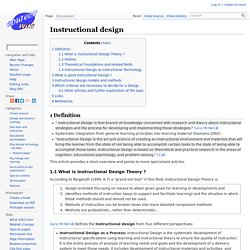

The ADDIE Model. Trends and Issues in IDT. Rebecca's Blog ETEC 561 Learning & Technology: Trends and Issues in IDT. 1.
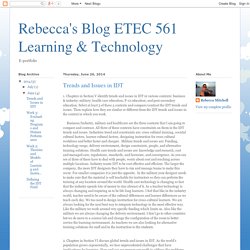
Chapters in Section V identify trends and issues in IDT in various contexts: business & industry; military; health care education; P-12 education; and post-secondary education. Select at least 3 of these 5 contexts and compare/contrast the IDT trends and issues. Then explain how they are similar or different from the IDT trends and issues in the context in which you work. Business/Industry, military and healthcare are the three contexts that I am going to compare and contrast.
All three of these contexts have constraints on them in the IDT trends and issues. 2. As the population of the world grows so does the knowledge of the people. Learning and Technology. 1.
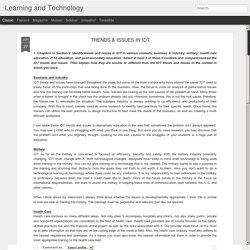
How do the definitions in the first chapter compare to your own definition of instructional or educational technology? What experiences or other influences have shaped your definition? How has your definition changed from examining the definitions in the first chapter of this book? The definitions definitely have grown and changed throughout the years as much as education and technology have grown. It’s interesting to see the definition go from a person who almost is only a “manager” to someone who is a “designer”.
I believe that IDT is more than just taking care of technology equipment but also the design and development of educational processes. 2. The lesson I am thinking about is one where the kids and I developed a survey and then created a graph with the information. Characteristic 1: Instructional Design is Student Centered I think this lesson was very student centered. Christy's Blog ETEC 561 Learning and Technology: Trends and Issues in IDT. 1.
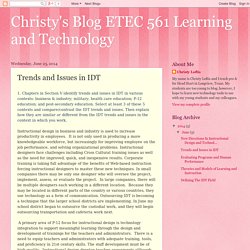
Chapters in Section V identify trends and issues in IDT in various contexts: business & industry; military; health care education; P-12 education; and post-secondary education. Select at least 3 of these 5 contexts and compare/contrast the IDT trends and issues. Then explain how they are similar or different from the IDT trends and issues in the context in which you work. Instructional design in business and industry is used to increase productivity in employees. It is not only used in producing a more knowledgeable workforce, but increasingly for improving employee on the job performance, and solving organizational problems. A primary area of P-12 focus for instructional design is technology integration to support meaningful learning through the design and development of trainings for the teachers and administrators. Those involved in that training as an instructional designer muse produce training that meet the requirements of military as well as the needs of the individual. 2.
Ed Tech World: Trends and Issues in IDT. Concept-map.pdf.
Principles of Instructional Design. In this post I examine and define instructional design, and share why it’s essential to the development of online courses.

“Design brings forth what would not come naturally“ Klaus Krippendorff Developing an online course that is engaging, promotes interaction, motivates learners, and above all facilitates learning is easier said than done. It’s even more challenging when trying to modify a face-to-face course for the online format. I know because I worked at a four-year college as lead curriculum designer where my job was to collaborate with faculty to transition their face-to-face courses to a 100% online course. During the process of converting more than fifteen courses I became even more appreciative of the principles and process of instructional design. The Design Process for Online Courses, by Giulia Forsythe (Flickr) I have over twelve years experience as an instructional designer, which includes creating management development courses and employee training programs. I. II. III. Instructional Design Models and Methods.
Instructional Design Models and Methods "Models, like myths and metaphors, help us to make sense of our world.

Whether derived from whim or from serious research, a model offers its user a means of comprehending an otherwise incomprehensible problem. An instructional design model gives structure and meaning to an I.D. problem, enabling the would-be designer to negotiate her design task with a semblance of conscious understanding. Models help us to visualize the problem, to break it down into discrete, manageable units. The value of a specific model is determined within the context of use. Group approach to blended course redesigns provides effective support, feedback.
By working together as a cohort, four faculty members at Penn State New Kensington provide each other with mutual support to rethink course design, face challenges, and devise solutions to effectively redesign face-to-face courses into a blended face-to-face and online format.

Abhinav Aima, instructor of communication; Natacha Bolufer-Laurentie, instructor in Spanish; Marcia Curler, instructor in radiological sciences; and Debra Majetic, instructor in radiological sciences were selected for the New Kensington Blended Initiative in March, after submitting proposals to campus director of academic affairs Andrea Adolph, who launched the project. Abhinav Aima, instructor of communication Natacha Bolufer-Laurentie, instructor in Spanish Marcia Curler, instructor in radiological sciences Debra Majetic, instructor in radiological sciences The Schreyer Institute is supporting the initiative in several ways, according to Sillman. The group shares these resources with each other on a website at. Leadership Through Instructional Design in Higher Education.
What Instructional Designers Do: Is this a career for you? What is instructional design?
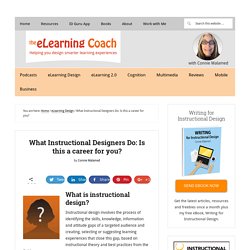
Instructional design involves the process of identifying the skills, knowledge, information and attitude gaps of a targeted audience and creating, selecting or suggesting learning experiences that close this gap, based on instructional theory and best practices from the field. Ideally, workplace learning improves employee productivity and value and enhances self-directed learning.
As social media technologies for learning become increasingly important to organizations and to individuals, instructional designers will need to focus on broad learning events and strategies that incorporate many approaches rather than on individual courses. See A Look into the Future below for more on this. What is the instructional design process?
Although the approaches people use to design and develop online instructional events vary widely, the common denominator is that the process is systematic and iterative. Instructional design. 1 Definition.
